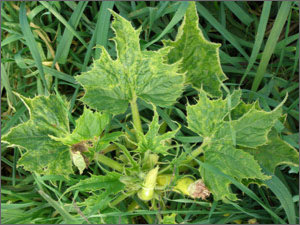Taking an environmentally sensitive approach to pest management
IPM Related Announcements
Published: September 1, 2012
Tomato Bacterial Canker Webinar Viewings
Tomato bacterial canker occurred in Ohio and Indiana this summer, as well as North, West and Central Missouri. This spurred Jaime Pinero of Lincoln University to organize presentations by plant pathologists from Ohio and Indiana on July 30th. Dan Egel from Purdue University covered the biology of the disease and Sally Miller of Ohio State University covered the prevention and control of it. These presentations were recorded and are available to be viewed. One sees the PowerPoint presentations and hears their recorded voices. Questions and answers during the presentation are also heard.
For the relatively few growers in the state that had some problem with this disease, viewing this ‘webinar’ is an excellent opportunity. This disease was more widespread in 2011; it is suspected as coming in on tomato seeds that year. In 2012 most farms that had the disease also had it the previous year, thus the occurrence of it this year is suspected as coming (primarily, if not entirely) from inoculum on the farm.
The dates and locations for scheduled viewings are as follows:
- Tuesday October 2nd (9 AM); Morgan County Seeds
- Thursday November 8th (9 AM); Morgan County Seeds
- Tuesday October 2nd (6 PM); North Missouri Produce Auction
Additional viewings can be scheduled if needed.
Endosulfan Phase Out
EPA is taking action to end the use of the pesticide endosulfan because it can pose unacceptable health risks to farmworkers and wildlife and can persist in the environment.
Effective July 31, 2012 the use of endosulfan was banned for most vegetable crops. The only crops it can be applied to are the ‘Group E’ vegetables.
Endosulfan is still allowed to be used until July 31, 2015 on the 'Group E' vegetable crops, which are:
- Peppers
- Potatoes
- Tomatoes
- Sweet corn
- Pumpkins
- Winter squash

Typical virus symptoms expressed by a zucchini this fall in WC MO.
Virus and Cucurbits
Four fields in the Rich Hill area tested positive viruses. All four had both Potyvirus group and Zucchini Yellow Mosaic virus. One field tested for a third, Papaya Ringspot Virus. Two of the viruses also occurred last year and were identified late season.
All three viruses are relatively common and transmitted by aphids. As aphid populations build up and successive plantings are made, the likelihood of the disease appearing increases. Early season incidents of the disease could be more destructive, as more plants would be likely to get infected.
Aster Yellows in Midwest Garlic
The dry spring is suspected of bringing in an early horde of leafhoppers, which then transmitted Aster Yellows to garlic (which is up very early). This disease is a minute bacterium termed ‘Phytoplasma’. Most folks only noticed afflicted heads at or after harvest small heads or ones that easily or quickly rotted. Any garlic head that is suspected of being affected should not be used as a source of planting cloves. The cloves are considered safe for human consumption.
Subscribe to receive similar articles sent directly to your inbox!
- IPM Annual Report 2016 Debut (01/18/17)
- FSMA Final Rule is Published but Questions Remain (12/29/15)
- Food Safety and Other Announcements (02/01/14)
REVISED: November 30, 2015